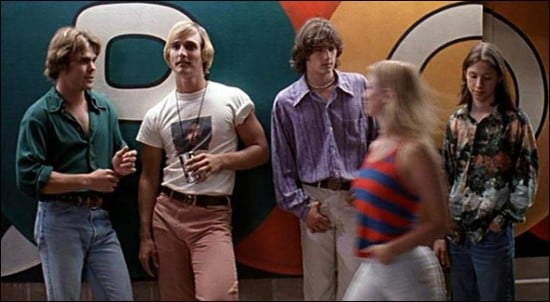Shocking Blocking (42)
By:
December 30, 2012

A movie that unfolds in a single day — whether Do the Right Thing or Dr. Strangelove — is often an example of synecdoche; it’s an effort to portray the tragedy and comedy of a sociocultural phenomenon (e.g., The Nuclear Arms Race, Being Young and Black) in snapshot form. However, a movie that unfolds in a single night — The Warriors, say, or Night of the Living Dead — is almost always an example not of synecdoche but metonymy. Such a movie’s contents represent an elusive phenomenon with which they may be closely associated, but of whose whole they form no part. So single-night movies aren’t snapshots, they’re moonlit summoning rituals; I’ve found that such conjurations work best when you watch them with the sound turned off. This is ironic in the case of a Richard Linklater movie, because there isn’t another writer-director alive — not even Wes Anderson — who so enjoys letting his characters jawbone. Mute Dazed and Confused, though, and you’ll discover that it’s not “about” Youth, The Seventies, or Getting High; instead, it’s an OGXer’s vision of a non-totalizing social totality. The restless, almost protean blocking via which we catch glimpses of Mitch Kramer (Wiley Wiggins) and other Youth Getting High in the Seventies is the means by which Linklater indirectly evokes an anarchic utopia the likes of which has never yet existed: one in which no square peg is ever forced into a round hole.
MORE POSTS BY THIS AUTHOR ABOUT RICHARD LINKLATER
An occasional series analyzing some of the author’s favorite moments in the positioning or movement of actors in a movie.
THIRTIES (1934–1943): It Happened One Night (1934) | The Man Who Knew Too Much (1934) | The Guv’nor (1935) | The 39 Steps (1935) | Young and Innocent (1937) | The Lady Vanishes (1938) | Mr. Smith Goes to Washington (1939) | The Big Sleep (1939) | The Little Princess (1939) | Gone With the Wind (1939) | His Girl Friday (1940)
FORTIES (1944–1953): The Diary of a Chambermaid (1946) | The Asphalt Jungle (1950) | The African Queen (1951)
FIFTIES (1954–1963): A Bucket of Blood (1959) | Beach Party (1963)
SIXTIES (1964–1973): For Those Who Think Young (1964) | Thunderball (1965) | Clambake (1967) | Bonnie and Clyde (1967) | Madigan (1968) | Wild in the Streets (1968) | Barbarella (1968) | Harold and Maude (1971) | The Mack (1973) | The Long Goodbye (1973)
SEVENTIES (1974–1983): Les Valseuses (1974) | Eraserhead (1976) | The Bad News Bears (1976) | Breaking Away (1979) | Rock’n’Roll High School (1979) | Escape from Alcatraz (1979) | Apocalypse Now (1979) | Caddyshack (1980) | Stripes (1981) | Blade Runner (1982) | Tender Mercies (1983) | Monty Python’s The Meaning of Life (1983)
EIGHTIES (1984–1993): Repo Man (1984) | Buckaroo Banzai (1984) | Raising Arizona (1987) | RoboCop (1987) | Goodfellas (1990) | Candyman (1992) | Dazed and Confused (1993) |
NINETIES (1994–2003): Pulp Fiction (1994) | The Fifth Element (1997)
OUGHTS (2004–13): Nacho Libre (2006) | District 9 (2009)
Joshua Glenn’s books include UNBORED: THE ESSENTIAL FIELD GUIDE TO SERIOUS FUN (with Elizabeth Foy Larsen); and SIGNIFICANT OBJECTS: 100 EXTRAORDINARY STORIES ABOUT ORDINARY THINGS (with Rob Walker).
